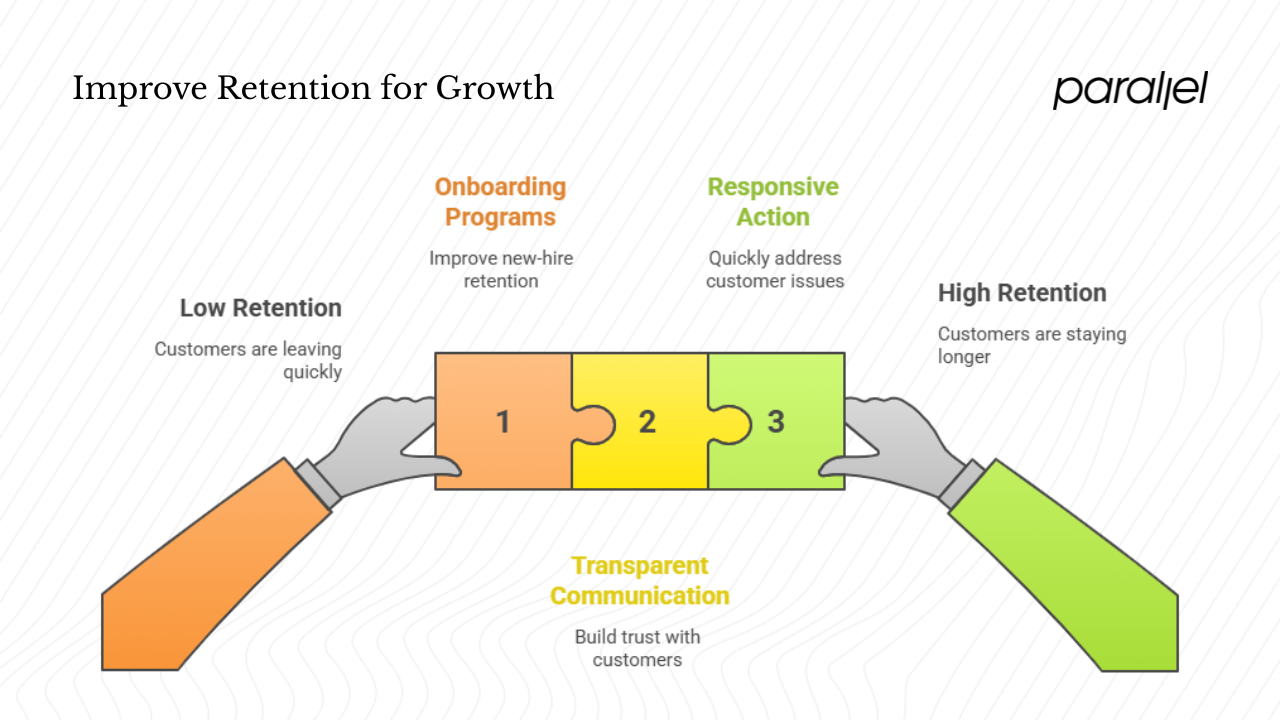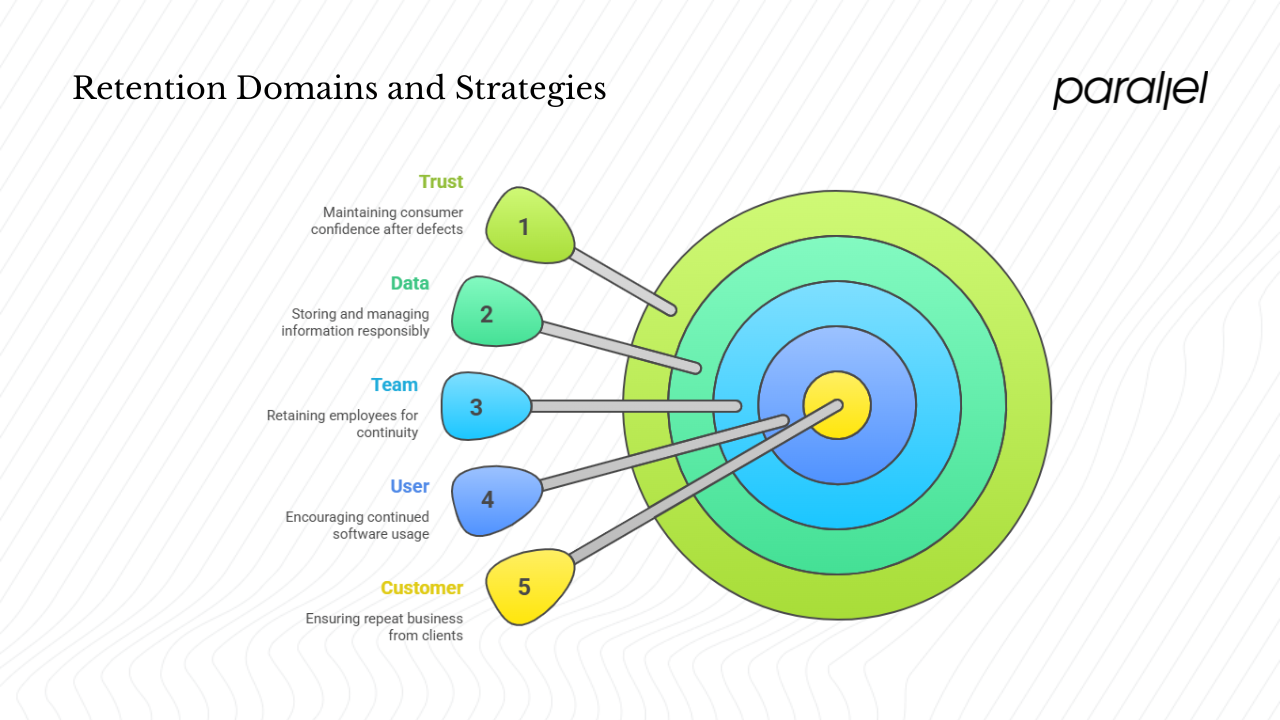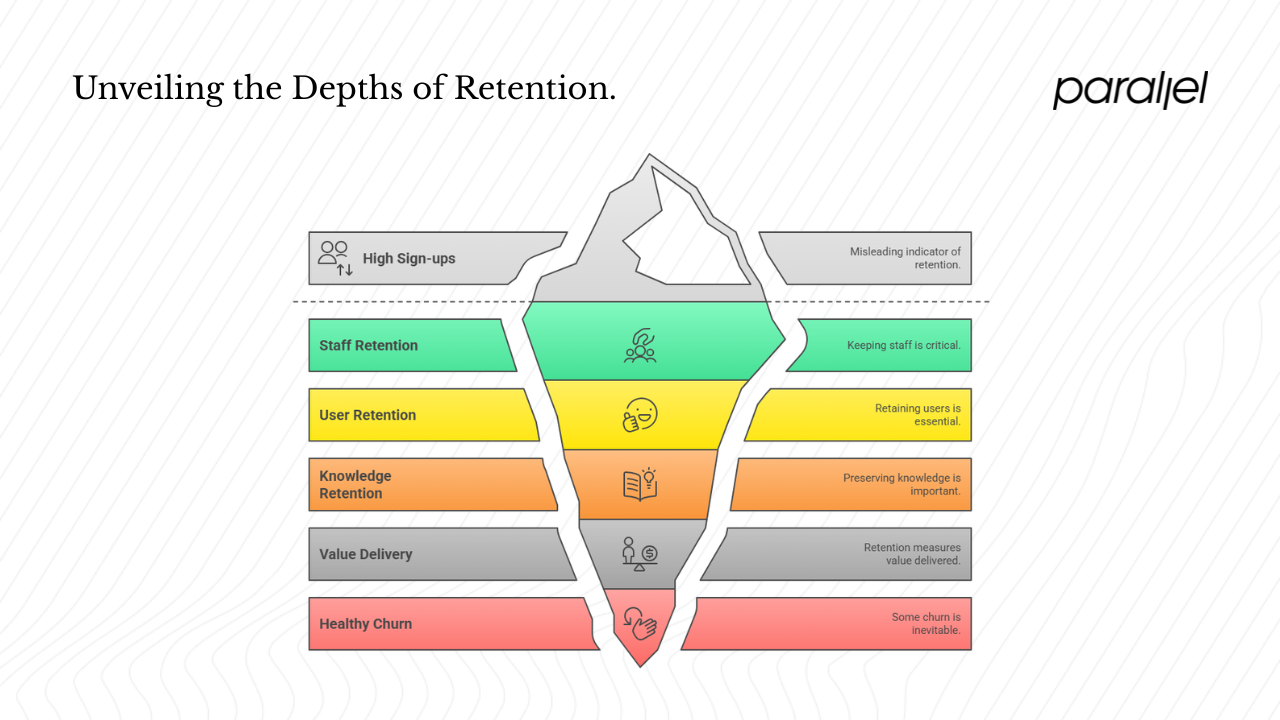What Does Retention Mean? Guide (2026)
Find out what retention means in business and customer success, including formulas and strategies to improve it.

Retention might be the simplest concept in business, yet asking what retention means reveals deeper insight than chasing acquisition metrics. Early‑stage founders often celebrate every new client, user or hire. They talk about sign‑ups, market share and release velocity. But without retention, those gains evaporate. Retention is not an afterthought; it is the practice of keeping what is valuable.
In this article I’ll demystify the term and show why product managers, designers and entrepreneurs should view retention as a central strategy. We’ll examine how the idea shows up across customers, users, staff, data and quality events, how to measure it and how to improve it. My aim is to help you build businesses that last rather than just launch.
What does retention mean?
When product people ask what retention means, they’re not just quoting a definition; they’re asking how to keep customers returning, how to make users come back, how to retain talented colleagues and how to store knowledge responsibly. These domains — loyalty, engagement, employment, information and trust after quality issues — will shape our exploration.

Retention flows from the verb “retain,” which means to keep or continue to have. In a startup context, that means keeping paying clients subscribed, ensuring users continue to open and use your software, encouraging team members to stay and grow, managing data so it remains available and relevant, and maintaining consumer trust even when defects arise.
So what does retention mean for a founder? It means valuing the clients, users and colleagues you already have and strengthening those ties.
Why retention deserves your attention
Retention signals value. Casey Winters, growth leader at Pinterest and Grubhub, observes that “great retention is the scalable way to grow a product. It’s the best indicator of product‑market fit”. If people return, renew and expand, your offering solves a real problem. Research backs this intuition: Harvard Business Review reports that acquiring a new customer costs five to twenty‑five times more than keeping an existing one. Bain & Company’s analysis shows that improving customer retention by just five percentage points can increase profits by twenty‑five to ninety‑five percent. Returning clients spend more, refer others and try new offerings, and organisations with high loyalty grow much faster.
Retention also affects internal health. High turnover is expensive and destabilising. Structured onboarding programs can improve new‑hire retention by 82% and boost productivity by over 70 %. Without such programs, roughly one in three new hires quits within three months. Memory loss matters, too. Psychology research shows that we forget about half of what we learn within an hour, 75% within a day and up to 90% within a week. If your onboarding, documentation or training is a one‑off event, most of that knowledge will be gone shortly after. Retention is not only about people but also about what they learn.
In the first quarter of 2025 there were 775 product recalls across major U.S. industries, with defective units increasing by 25 %citybuzz.co. Research shows that 94% of consumers remain loyal when brands are transparent and responsive. How you handle missteps determines whether clients continue to trust you. This again raises the question: what does retention mean when things go wrong? It means preserving loyalty through honesty and quick action.

Domains of retention and why they matter
Retention isn’t one metric; it shows up in different domains. Understanding these contexts helps you see how to protect what you’ve worked so hard to build.

1) Keeping paying clients: customer loyalty
Customer retention is the share of paying clients who continue to pay after a given period. Customer retention is measured by comparing the total number of customers who renew their service or repurchase a product against the starting customer count. Industry standards for retention rates vary significantly:
- Media and Professional Services: Approximately 84%
- Financial Services: Around 78%
- Travel: Roughly 55
- Web Commerce: About 38%.
These numbers remind us that retention goals must be contextual. Instead of celebrating sign‑ups, watch whether groups of new customers stick around. High retention signals that your service delivers ongoing value; low retention means there is a leak to fix.
2) Making users come back: engagement and stickiness
User retention tracks whether people keep using the software over time. It can be expressed as daily or weekly active users as a percentage of the original sign‑up group. High retention means your service becomes a habit; low retention indicates performance or value issues. Research shows that 73% of users uninstall an app after a single crash, so reliability and a clear first‑use experience matter.
Different types of software use different windows for measurement. Social products often track daily activity, while enterprise tools look at weekly or monthly usage to account for longer decision cycles. Comparing your numbers to the right frame will give you a more meaningful picture.
3) Keeping your team: employee tenure
Team retention tracks how many colleagues stay and how long they stay. High turnover disrupts momentum and forces you to rebuild context. Structured onboarding and mentorship can improve new‑hire retention dramatically. Watching tenure by role helps identify where people are leaving.
4) Protecting information: data and memory
Data retention refers to storing information for defined periods and discarding it responsibly. A clear policy helps control costs, reduce risk and meet compliance requirements. Retention also applies to human memory: without reinforcement, we forget most new knowledge within days. Break learning into smaller pieces and repeat important points to make information stick.
5) Keeping trust after defects: recall management
Product recalls illustrate another kind of retention: keeping trust when something goes wrong. In early 2025 there were 775 recalls and a 25% increase in defective units. Research shows that 94% of consumers remain loyal to brands that are transparent during crises. Acting quickly and openly preserves loyalty through clear communication and remedies.
Measuring retention without getting lost in formulas
You don’t need complex formulas to gauge retention. The core idea is to compare how many people or items you have at the end of a period with how many you had at the start. For clients, divide the number who renew by the number you began with. For users, count how many of the original sign‑up groups are still active after a set time. For staff, compare your starting headcount to those still on board. Choose a timeframe that suits your model and group people by when they joined so you don’t mix new arrivals with long‑time supporters. High raw counts can hide churn, so look at percentages and trends rather than vanity metrics.
Practical ways to improve retention
When you quantify how many people stay from one period to the next, you’re turning the question of what retention means into numbers you can act on.
Improving retention isn’t about quick hacks; it’s about delivering ongoing value and creating an environment where people want to stay. Here are strategies for the different domains.
Retention improves when you deliver value consistently. Here are practical actions across domains:
- Deliver a smooth introduction. Remove friction from sign‑up and onboarding. Pair new colleagues with mentors and show clients essential features early. Structured onboarding improves new‑hire retention and productivity.
- Build habits and encourage engagement. Identify the job people hire your product to do and design prompts that encourage repeated use. Returning customers spend more and refer others, so nurture communities and provide feedback to sustain interest.
- Watch for warning signs. Declining usage, unresolved support issues or late payments often precede churn. Reach out proactively when you see these patterns. For staff, look for dwindling participation or burnout and address issues before people leave.
- Personalise responsibly. Sprinklr reports that 77% of customers choose brands that personalise experiences. Use data ethically to customise prompts and support. Customised guidance helps users discover features they might otherwise miss. For colleagues, match assignments to their interests and strengths.
- Make renewal easy and invest in growth. Tell clients before renewals and make pauses or downgrades simple. Provide professional development and learning opportunities so colleagues see a future with you.
- Handle information thoughtfully. Keep only the data you need and protect it. Break learning into smaller lessons and reinforce important points to improve knowledge retention.
- Be transparent during defects. When something goes wrong, communicate openly and act quickly. Transparency retains loyalty during recalls and other crises.
Common misunderstandings about retention

- More sign‑ups equal good retention. High download numbers can hide high churn. Measure how many people stay, not just how many arrive.
- Retention only applies to customers. Keeping staff, users and knowledge is just as critical to product success.
- Retention is purely a growth metric. It measures value delivered. People return when their needs are met.
- Retention means zero churn. Some churn is inevitable. The goal is healthy retention relative to your business model and stage.
Conclusion
Retention is more than keeping people; it’s about creating ongoing value and trust. For leaders it signals strategic health. Holding onto paying clients gives you predictable revenue and higher lifetime value, which lowers the cost of acquisition. Product managers use retention curves to decide which features to build and when to pivot: flat curves show healthy habits while steep drop‑offs indicate misaligned value.
Team leads know that keeping talented colleagues reduces hiring expenses and preserves momentum. When a company pays attention to retention, marketing and product work together, support invests in long‑term satisfaction and design focuses on clarity over novelty. Ignoring retention produces hidden costs: advertising spend climbs to replace churned users, brand reputation suffers and the team becomes reactive instead of proactive.
Whether you’re building a consumer app, an enterprise platform or a service business, the question of what retention means should guide your choices. Focus on repeat value instead of one‑time wins, invest in the experience from first touch to long‑term engagement, and manage information responsibly. The payoff is a sustainable product and a team that thrives.
FAQ
Q1. What does it mean to be retention‑focused?
Being retention‑focused means actively maintaining long‑term connections. It involves keeping clients subscribed, ensuring users return, encouraging colleagues to stay and preserving data responsibly rather than constantly chasing replacements.
Q2. What is retention in simple terms?
Retention means holding on to something you already have — whether customers, users, employees, data or lessons — instead of letting it slip away. In product contexts it measures how many people come back and how much value they continue to gain from your offering.
Q3. What does retention mean in a job?
In employment, retention refers to how long people stay at an organisation and the company’s ability to keep them. High retention means colleagues remain engaged and contribute over a longer period; low retention signals issues with clarity, rewards or leadership. Structured onboarding can improve new‑hire retention by more than 80 %.
Q4. What’s another word for retention?
Synonyms include maintenance, keeping, preservation, holding and conservation. Each conveys the idea of continuity.




.avif)









